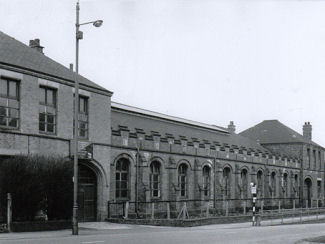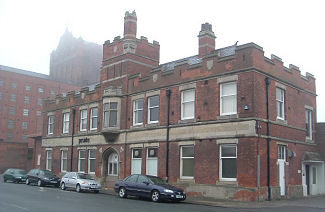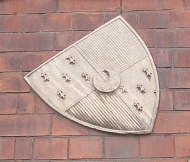Grimsby
5th Battalion Lincolnshire Regiment; headquarters [plus A & B Companies], Infantry Drill hall, Doughty road
(Both references Kelly 1913)
Head quarters, 2nd and 3rd Lincolnshire Batteries
1st North Midland Ammunition Column, Artillery Drill hall, Victoria street
Also described as Artillery Barracks in Kelly, 1913,
(All the above addresses from Kelly, 1913)
Kelly, 1896, also lists artillery barracks (Central Market), infantry armoury (Bull Ring) and drill hall (Corn Exchange).
Kelly, 1913, also describes the Doughty road premises as Artillery Barracks and records their: ‘strength; - 1st Battery, 115; 2nd Battery, 197; 3rd Battery, 211, including Ammunition Column to Batteries; Head Quarter Staff, 23.’
A year after Kelly’s staff made their notes, war was declared and on August 4th, 1914, the Territorials were recalled from camp in Bridlington. Before their mobilisation, they were billeted at the Drill Hall in Doughty road, as well as various other locations in the town, including schools and the docks. After ten days, they departed for Belper, their first destination in a journey which took in Luton and Stansted, and eventually to France as part of the 46th Division.
The archive photographs of this Drill Hall, taken in 1964, show a rather grand single storey building with a crenellated parapet surmounting a row of arched windows punctuated by buttresses. It was demolished in the 1980s and we have been informed that the site is now a car park.
The building is constructed from red bricks with limestone ashlar detail and a Welsh slate roof. The former artillery barracks, which included a drill hall, was taken over by Albert Gait Printers in the mid 1930’s and has remained as a printing works to date with the same company albeit changing its name to Wyndeham Gait. The façade and office accommodation is almost unchanged, whilst the interior is much as it was in the 1930s apart from being full of modern printing machinery. The building has a conservation order on it and is listed as Grade II with North East Lincolnshire Council. [2006]
Drill Hall, Doughty road
Drill Hall, Victoria street
Hainton avenue
Augusta street
Drill Hall, Victoria street
Hainton avenue
Augusta street
Doughty road Drill Hall (Infantry Drill Hall)
D Squadron Lincolnshire Yeomanry 5th Battalion Lincolnshire Regiment; headquarters [plus A & B Companies], Infantry Drill hall, Doughty road
(Both references Kelly 1913)
Victoria street Drill Hall (Artillery Drill Hall)
1st North Midland Brigade, Royal Field ArtilleryHead quarters, 2nd and 3rd Lincolnshire Batteries
1st North Midland Ammunition Column, Artillery Drill hall, Victoria street
Also described as Artillery Barracks in Kelly, 1913,
(All the above addresses from Kelly, 1913)
Hainton avenue:
‘Notts & Derby Mounted Brigade Field Ambulance, Royal Army Medical Corps; head quarters, 259 Hainton avenue’ B Section (Kelly 1913) Augusta street:
Depot of 239 (later changed to 238) BatteryKelly, 1896, also lists artillery barracks (Central Market), infantry armoury (Bull Ring) and drill hall (Corn Exchange).
Doughty road Drill Hall - further information:
The Times, Thursday, February 12th, 1891: ‘The Right Hon. E. Stanhope, Secretary for War, and Sir Edward Watkin will take part in the opening of a new drill-hall for the Volunteers at Grimsby at the end of next month.’Kelly, 1913, also describes the Doughty road premises as Artillery Barracks and records their: ‘strength; - 1st Battery, 115; 2nd Battery, 197; 3rd Battery, 211, including Ammunition Column to Batteries; Head Quarter Staff, 23.’
A year after Kelly’s staff made their notes, war was declared and on August 4th, 1914, the Territorials were recalled from camp in Bridlington. Before their mobilisation, they were billeted at the Drill Hall in Doughty road, as well as various other locations in the town, including schools and the docks. After ten days, they departed for Belper, their first destination in a journey which took in Luton and Stansted, and eventually to France as part of the 46th Division.
The archive photographs of this Drill Hall, taken in 1964, show a rather grand single storey building with a crenellated parapet surmounting a row of arched windows punctuated by buttresses. It was demolished in the 1980s and we have been informed that the site is now a car park.
Drill Hall, Victoria street - further information:
The Times, Thursday April 2nd, 1891: ‘Mr. E. Stanhope, Secretary of State for War, addressed a large public meeting yesterday afternoon at the opening of a new artillery drill hall at Grimsby.’The building is constructed from red bricks with limestone ashlar detail and a Welsh slate roof. The former artillery barracks, which included a drill hall, was taken over by Albert Gait Printers in the mid 1930’s and has remained as a printing works to date with the same company albeit changing its name to Wyndeham Gait. The façade and office accommodation is almost unchanged, whilst the interior is much as it was in the 1930s apart from being full of modern printing machinery. The building has a conservation order on it and is listed as Grade II with North East Lincolnshire Council. [2006]
Thank you to Peter Wheatley of Wyndeham Gait for the updated details.
The archive photographs of the Doughty road Drill Hall are used with permission from Grimsby Library.
Thank you to Steve Bramley for the photographs of the Victoria road Drill Hall and for the additional information he supplied.
The archive photographs of the Doughty road Drill Hall are used with permission from Grimsby Library.
Thank you to Steve Bramley for the photographs of the Victoria road Drill Hall and for the additional information he supplied.

Doughty road drill hall

Doughty road drill hall

Victoria street

Victoria street

Victoria street - Arms adjacent to entrance

Victoria street - Arms adjacent to entrance
© All material is copyright - refer to the
Terms of Use
the first attempt at content
Introduction
About
Anatomy
Drill
 Database
Database
 Memorabilia
Memorabilia
Resources Glossary
Saving Halls Participate Contact What's New? Terms of Use
Drill
 Database
Database Memorabilia
MemorabiliaResources Glossary
Saving Halls Participate Contact What's New? Terms of Use
The Drill Hall Project - Charting a neglected legacy